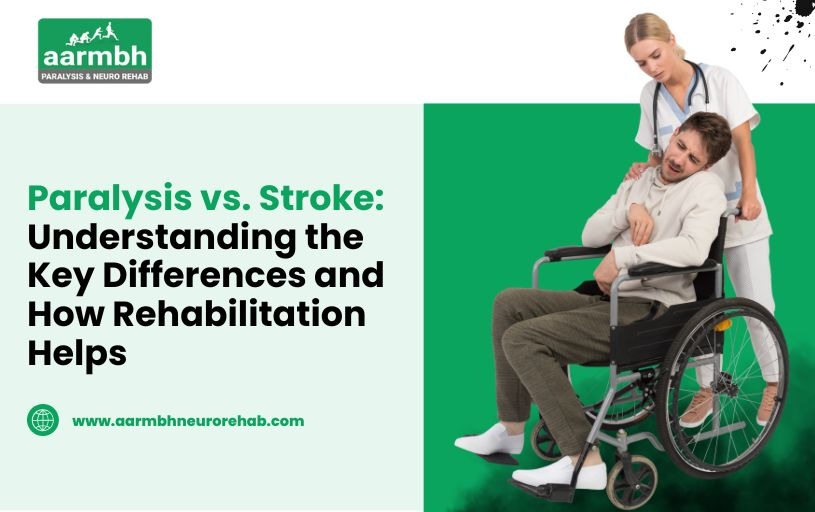Paralysis vs. Stroke: Understanding the Key Differences and How Rehabilitation Helps
Learn about the differences between paralysis and stroke, their causes, symptoms, and how rehabilitation therapies help patients recover mobility, independence, and quality of life. Start your recovery journey today.
PARALYSIS VS. STROKE
Dr. Amol Nikam
7/23/20253 min read


When it comes to neurological disorders, stroke and paralysis are two terms that often cause confusion. While they are closely linked, they are not the same. A stroke is a sudden medical condition affecting the brain, whereas paralysis is often a result of stroke or other injuries to the brain or spinal cord.
In this blog, we will:
Clarify the difference between stroke and paralysis
Explain how stroke rehabilitation therapy and paralysis rehabilitation work
Highlight the importance of early intervention
Guide you on choosing the right rehabilitation centre, especially if you're looking for one in Nashik
What is a Stroke?
A stroke is a medical emergency that occurs when the blood flow to a part of the brain is interrupted or reduced. Without oxygen and nutrients, brain cells begin to die within minutes. This sudden event can lead to long-term disability and, in many cases, paralysis.
Types of Stroke:
Ischemic Stroke – Caused by a blockage in a blood vessel (most common).
Haemorrhagic Stroke – Caused by bleeding in or around the brain.
Transient Ischemic Attack (TIA) – Also called a mini-stroke; symptoms are temporary but a warning sign of a future stroke.
Common Symptoms:
Numbness or weakness, especially on one side of the body
Trouble speaking or understanding speech
Vision problems
Sudden dizziness or loss of balance
Severe headache with no known cause
What is Paralysis?
Paralysis is the loss of voluntary muscle movement in one or more parts of the body. It can be partial or complete, temporary or permanent. Paralysis is not a disease but a symptom that arises from underlying neurological damage, most commonly caused by stroke, spinal cord injury, or neurological disorders.
Types of Paralysis:
Monoplegia: Paralysis of one limb
Hemiplegia: Paralysis on one side of the body (often due to stroke)
Paraplegia: Paralysis of the lower body
Quadriplegia: Paralysis of all four limbs
How Does Stroke Cause Paralysis?
After a stroke, especially if the motor-control regions of the brain are affected, a person may experience hemiplegia (paralysis on one side). This happens because damaged neurons can no longer send signals to the corresponding muscles.
Depending on the severity and location of the stroke:
Mild strokes may cause weakness or coordination issues
Severe strokes may lead to complete paralysis on one side
This is where stroke rehabilitation physiotherapy plays a vital role in restoring function and mobility.
Importance of Stroke and Paralysis Rehabilitation
What is Stroke Rehabilitation?
Stroke rehabilitation is a structured, long-term program designed to help stroke survivors recover their physical, cognitive, and emotional functions. It includes:
Stroke rehabilitation exercises
Physical therapy for stroke
Occupational therapy
Speech therapy
Cognitive rehabilitation
What is Paralysis Rehabilitation?
Paralysis rehabilitation focuses on:
Regaining muscle function where possible
Improving mobility with or without assistive devices
Preventing complications like pressure ulcers or joint stiffness
Building patient confidence and independence
Both types of rehabilitation should begin as early as possible, ideally within the first few days of hospital admission.
Common Stroke Rehabilitation Exercises
Range-of-motion exercises – Improve flexibility and joint movement
Strength training – Build muscle strength in weak limbs
Balance and coordination training – Prevent falls and improve posture
Mirror therapy – Helps restore movement using visual feedback
Hand and finger exercises – Regain grip and hand function
All these are part of a professional stroke rehabilitation therapy program tailored to individual needs.
Physical Therapy for Stroke Recovery
Physiotherapy for stroke patients helps re-train the brain and muscles using:
Electrical stimulation
Treadmill gait training
Functional task training (e.g., climbing stairs, walking)
Neuromuscular re-education
Patients usually work with a stroke rehabilitation physiotherapist to gradually restore independence in daily activities.
Why Choose a Professional Rehabilitation Centre?
If you’re searching for expert help, selecting the right Paralysis Rehabilitation Centre is essential for:
Access to a multidisciplinary team (physiotherapists, neurologists, speech therapists)
Customized therapy plans
Psychological support
Advanced rehab equipment and technology
Looking for a Rehabilitation Centre in Nashik?
If you're located in or around Nashik, consider seeking a specialized rehabilitation centre in Nashik that offers:
Comprehensive stroke and paralysis care
Individualized physiotherapy programs
State-of-the-art equipment
Skilled, certified rehabilitation specialists
Comfortable inpatient and outpatient care options
Rehabilitation is not a one-size-fits-all solution, it’s a journey. The right centre can make all the difference in your or your loved one’s recovery.
While stroke is a sudden medical event and paralysis is often its aftermath, both require urgent and ongoing care. The combination of stroke rehabilitation therapy and paralysis rehabilitation can significantly improve the quality of life and restore independence.
Whether it’s early stroke rehabilitation exercises or long-term physical therapy for stroke, consistency and professional guidance are key. And if you're in Nashik, finding a trusted Paralysis Rehabilitation Centre can be your first step toward healing.
Ready to Take the First Step?
Looking for a reliable rehabilitation centre in Nashik?
Reach out to our expert team and begin your personalized stroke or paralysis recovery program today.
Aarmbh Neuro Rehabilitation Services
© 2025. All rights reserved.
